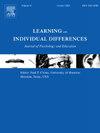Does distributing non-interactive teaching contribute to learning? Students' academic self-concept and work ethic matter
IF 9
1区 心理学
Q1 PSYCHOLOGY, EDUCATIONAL
引用次数: 0
Abstract
Explaining learning contents to a fictitious peer (i.e., non-interactive teaching) improves learning, yet this effect is modest, heterogeneous, and likely influenced by individual differences. We examined whether the effectiveness of non-interactive teaching could be increased by incorporating drawing or distributing teaching. We realized a 3 × 2 field experimental design (N = 317), crossing the factors learning activity (restudy, teaching-only, teaching + drawing) and timing (after the study phase or distributed three times throughout the study phase). Overall, teaching resulted in better immediate conceptual knowledge than restudying, mediated by the level of completeness. This teaching effect was most pronounced in the after-study condition. However, drawing did not enhance conceptual knowledge. Students who taught underestimated their immediate knowledge. No lasting effects were observed. Students with higher academic self-concept or work ethic benefited more from teaching, highlighting the moderating role of inter-individual differences for instructional interventions.
Educational relevance and implications statement
This classroom study demonstrates that non-interactive teaching is an effective instructional method in secondary school physics education. The findings highlight the importance of considering students' individual differences, such as academic self-concept or work ethic, when designing such learning activities. These insights emphasize the need for adapted and differentiated approaches that can better account for individual differences, ensuring that non-interactive teaching can be effective across diverse student populations.
分发非互动式教学对学习有帮助吗?学生的学术自我概念和职业道德很重要
向一个虚构的同伴解释学习内容(即,非互动教学)可以提高学习效果,但这种效果是适度的,异质性的,可能受到个体差异的影响。我们研究了是否可以通过结合绘图或分配教学来提高非互动教学的有效性。我们实现了3 × 2的现场实验设计(N = 317),跨越了学习活动(再学习、纯教学、教学+绘画)和时间(在研究阶段后或在整个研究阶段分布三次)的因素。总体而言,教学比重新学习产生了更好的直接概念知识,这是由完整性水平介导的。这种教学效果在课后状态下最为明显。然而,绘画并没有增强概念知识。教书的学生低估了他们的直接知识。没有观察到持久的影响。学业自我概念或职业道德水平较高的学生从教学中获益更多,表明个体间差异对教学干预的调节作用。教育相关性与意涵陈述本课堂研究证明非互动教学在中学物理教学中是一种有效的教学方法。研究结果强调了在设计此类学习活动时考虑学生个体差异的重要性,例如学术自我概念或职业道德。这些见解强调需要采用适应和差异化的方法,以更好地解释个体差异,确保非互动式教学在不同的学生群体中有效。
本文章由计算机程序翻译,如有差异,请以英文原文为准。
求助全文
约1分钟内获得全文
求助全文
来源期刊

Learning and Individual Differences
PSYCHOLOGY, EDUCATIONAL-
CiteScore
6.60
自引率
2.80%
发文量
86
期刊介绍:
Learning and Individual Differences is a research journal devoted to publishing articles of individual differences as they relate to learning within an educational context. The Journal focuses on original empirical studies of high theoretical and methodological rigor that that make a substantial scientific contribution. Learning and Individual Differences publishes original research. Manuscripts should be no longer than 7500 words of primary text (not including tables, figures, references).
 求助内容:
求助内容: 应助结果提醒方式:
应助结果提醒方式:


